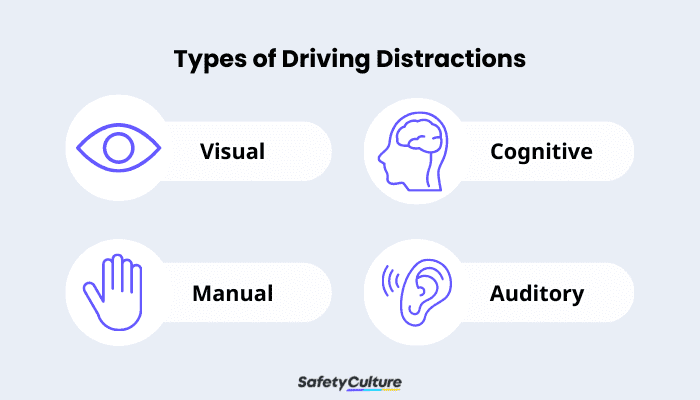What is Distracted Driving?
The US Centers for Disease Control and Prevention (CDC) defines distracted driving as the act of doing something else in addition to driving that ends up diverting the driver’s attention from the road. In the US, Distracted Driving Awareness Month is observed every April wherein multiple government and non-government organizations work together to help reduce distracted driving.
Types of Distractions

Types of Driving Distractions
The CDC divides the most common causes of distracted driving into three types:
- Visual distractions: things that make the driver takes their eyes off the road to look at something else
- Manual distractions: things that take up the driver’s attention and encourage them to remove their hands from the wheel to hold or do something else
- Cognitive distractions: things that distract the driver enough that they stop thinking or being mindful about driving, even while on the road
Some states, healthcare institutions, and law firms have added another classification: auditory distractions. The most common example of this kind of distraction is loud or catchy music but any loud sound can be classified as an auditory distraction as well. These kinds of distractions are dangerous as they can impair hearing and take the driver’s attention from the road, leading to a hampered attention span or awareness of the world around them.
Common Causes of Distracted Driving
According to the National Highway Traffic Safety Administration (NHTSA), in 2019, the most concerning and common causes of distracted driving in the US are related to:
- reading and sending texts;
- answering calls;
- adjusting or recalibrating vehicle audio or climate controls;
- eating;
- drinking;
- smoking;
- daydreaming; and
- seeing or hearing something or someone else outside the vehicle.
However, the top two most common causes of distracted driving are driving while on the phone or other devices and Driving Under the Influence (DUI). Electronic device-related cases of distracted driving, in particular, are growing to be prevalent. Cellphones, specifically, are often identified as the cause of cases of distracted driving. Although many devices are now touch-free or hands-free, they are still considered to be hindrances to driving as they could still take attention away from the road and cloud one’s judgment. Because of this, many states have created their own laws regulating or banning the use of cellular phones and other electronic devices when driving.
DUI or Driving While Intoxicated/Impaired (DWI) due to alcohol or other substances is also a leading cause of distracted driving. A study shows that having a higher blood alcohol level often increases the chances of a fatal car crash, leading to one alcohol-related car fatality every thirty minutes in the US. Additionally, up to 40% of all total fatal crashes in the country involve alcohol consumption of varying amounts, with drivers aged 20 and under being five times more likely to be involved in alcohol-related crashes compared to drivers over 30. While some states have created legal provisions penalizing drunk driving, it’s still a leading cause of distracted driving today.
Risks
The top risks distracted driving brings are death and injury. In 2019, the US saw over 3,100 people killed and 424,000 injured from accidents and crashes brought about by distracted driving. Additionally, around one out of five people who died from these crashes were not in the crashed vehicles or nonoccupants of the vehicle, as they were just walking and biking nearby when they got harmed. Drivers were found to be the next most susceptible to injuries and death after the nonoccupants.
Studies by the NHTSA have also found that older teens and young adults are more likely to be distracted when driving, leading to collisions and other accidents while on the road. Nine percent of drivers aged 15 to 20 found in car crashes were found to be distracted at the time of the incident, making up the highest percentage of all drivers involved in crashes caused by distracted driving. The same age group has also been studied to be more likely to be distracted by their phones while on the road, along with the 21 to 24 age group.
Incidents caused by distracted driving also cost a lot of money. A 2014 federal study stated that distracted driving costs the US around $165 billion yearly. Highway crashes, of which 17% of cases are caused by distracted driving, amount to $871 billion in total, with $277 billion going to physical damage and $594 billion attributed to traffic congestion and affected or lost productivity. This doesn’t take into account yet how hospital emergency room visits for car-related accidents average at $3,300, and car repairs start at $50 and can go up to $2,500.
For businesses, especially those in the field of fleet management, distracted driving is also something to consider when creating plans for fleet safety. Injured drivers and out of service vehicles will not only impact safety and costs, but they can also negatively affect how a business operates in the long run.
Create Your Own Driving Safety Checklist
Eliminate manual tasks and streamline your operations.
Get started for FREESafety Tips
Some places offer classes specifically for combating distracted driving. While general driving schools also offer tips and guides for driving without distractions, classes made specifically for addressing distracted driving are more in-depth. There are also online training or classes for driver safety that tackle distracted driving as well.
However, the main safety tip the CDC has for drivers to prevent driving distractedly is to avoid all sorts of distractions within the vehicle. Although the most common distraction in vehicles is considered to be mobile phones, the CDC stresses that the act of fixing mirrors, eating, and selecting music while on the road are also distractions to be avoided.
Passengers can also help avoid incidents brought about by distracted driving. They can help drivers by identifying distractions for them and addressing them. Passengers can also help with navigation and other tasks so their drivers can stay focused on the road.
Another way to ensure safety on the road and avoid distractions is by using a checklist. Having a checklist can help you check your vehicle for any distractions before you drive them. With a checklist, you can be reminded to fix your mirrors before driving, see your gas level, set your radio, ensure everything is where it should be, and clean your car before setting for the road. A checklist can also help with car maintenance, allowing drivers to check and address issues before driving, preventing the occurrence of more distractions on the road.
SafetyCulture (formerly iAuditor) for Driving Safety
Consider using a digital checklist to help you drive without distractions. You can use digital checklists not only during Distracted Driving Awareness Month but also anytime you’re out for a ride. Doing so will ensure both your safety and the safety of others.
SafetyCulture is a digital inspection app that allows you to use and create checklists from your phones and access them later on. You can also use pre-made templates from the Public Library and edit them as needed to better suit your needs.
SafetyCulture also lets you:
- Attach photos and notes to your inspections for proof or reference
- Create analytical reports based on your completed inspections
- Raise Issues, assign Actions, and provide a Heads Up on your driving status if you’re in an organization
- Use QR codes to access checklists on the go without opening the mobile app




